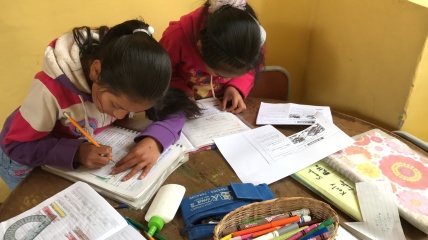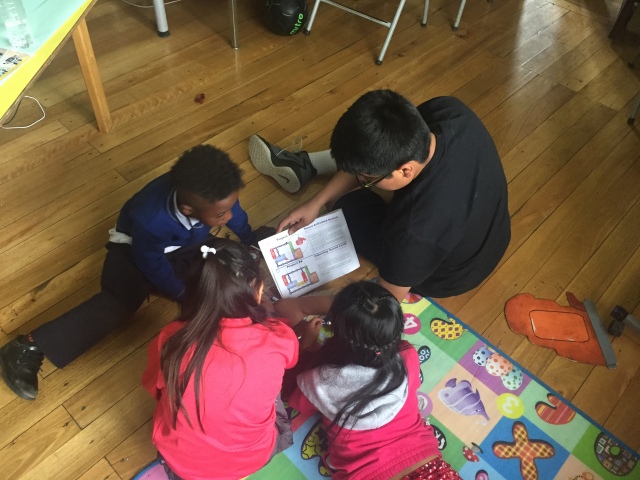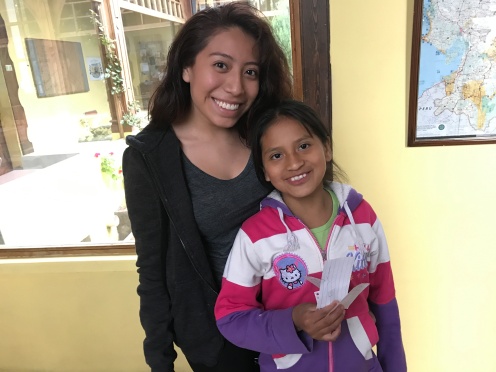by Cindy Vaquero and Kevin Rothman
One of the highlights so far has been our work with the children in the after school program at Casa Victoria. On the first day, we were excited and nervous for the local children to arrive. Although we talked amongst ourselves for months and heard from Mamalicia what the typical schedule is for the program, we still did not know exactly what to expect. How many kids would come? How old were they going to be? What do they like to do? These were all questions that lingered for us.
When the students first arrive to Casa Victoria, they have an hour of free time. While  many of them choose to play, others use the time to take care of their homework so they can participate in the planned activities for the second and third hour at Casa Victoria. We noticed a few young ladies that came inside and sat at a table in a quiet corner and took out their school work. We overheard them talking about how they did on their reading test and what they had for home work. Hearing this sparked our interest so we decided to join them at the table. When Cindy asked about their test, the girls all wanted to tell her their grades. This helped break the ice and opened the door for us to see more of their school work.
many of them choose to play, others use the time to take care of their homework so they can participate in the planned activities for the second and third hour at Casa Victoria. We noticed a few young ladies that came inside and sat at a table in a quiet corner and took out their school work. We overheard them talking about how they did on their reading test and what they had for home work. Hearing this sparked our interest so we decided to join them at the table. When Cindy asked about their test, the girls all wanted to tell her their grades. This helped break the ice and opened the door for us to see more of their school work.
The first thing we noticed was that their home work involved copying worksheets and textbook pages exactly into their notebook – including pictures!  When Cindy asked if this is a typical assignment, they all said that this is the normal routine for their learning. We were shocked to hear this. As a student, this has not been the learning experience for Cindy. Although there are times when she is asked to answer questions from textbooks and on worksheets as well as copy definitions of words, she has never been asked to copy these items exactly. Mr. Rothman could only think about how he, as an administrator, works very hard with teachers to move away from rote learning experiences in an effort to involve students in more authentic learning experiences. Both of us wondered what value the teachers of these young ladies thought there was in having them copy things directly into their notebook. We also thought about how students in the United States would react if asked to do this every day. Not very well, we thought.
When Cindy asked if this is a typical assignment, they all said that this is the normal routine for their learning. We were shocked to hear this. As a student, this has not been the learning experience for Cindy. Although there are times when she is asked to answer questions from textbooks and on worksheets as well as copy definitions of words, she has never been asked to copy these items exactly. Mr. Rothman could only think about how he, as an administrator, works very hard with teachers to move away from rote learning experiences in an effort to involve students in more authentic learning experiences. Both of us wondered what value the teachers of these young ladies thought there was in having them copy things directly into their notebook. We also thought about how students in the United States would react if asked to do this every day. Not very well, we thought.
On the second day, we again decided to help students with their school work during their free time. Cindy helped one of the young ladies, Johanna, study for a science test on circuits. Johanna was trying to read over her notes – keep in mind this is an exact replica

of the textbook. Cindy noticed that she was struggling to memorize the definitions for the test. This was an opportunity for Cindy to introduce flash cards, a tool she often uses to study to help her memorize definitions. Because this was totally new to Johanna, Cindyhad to show her step by step how to make the flashcards (cut from paper) and how to use them as a tool for studying. Johanna really appreciated the help and it really seemed to help her remember the information. The other exciting aspect was the fact that she was learning about circuits. We happened to bring with us, as part of our donation to Casa Victoria, Snap Circuits, which is a hands on way to learn about the same content that was going to be on her test.

We are happy that we were able to see a bit into the school life of the children here in  Ecuador. We are also glad that Cindy was able to introduce a new tool for studying and that our donated items will provide authentic learning opportunities for the children at Casa Victoria. It helped us appreciate the school system we have in the United States and especially the learning opportunities at Excelsior Academy. This experience has also left us with a few lingering questions: What does a typical school day look like? Are the teachers strict? What resources are available for learning in school? Is there high school and how is it different from our school?
Ecuador. We are also glad that Cindy was able to introduce a new tool for studying and that our donated items will provide authentic learning opportunities for the children at Casa Victoria. It helped us appreciate the school system we have in the United States and especially the learning opportunities at Excelsior Academy. This experience has also left us with a few lingering questions: What does a typical school day look like? Are the teachers strict? What resources are available for learning in school? Is there high school and how is it different from our school?




Thanks for sharing your observations here – I appreciated thinking about rote learning and the value of mimic-ing an existing text. I suppose there is something for me when I write things down and SEE them, I might remember more but writing down in a vacuum without processing, that’s another story. How cool that Cindy could share her method for using flashcards.
LikeLiked by 1 person
Thank You so much for reading our blog post. I am glad you liked it and yes thank you, I was proud that the results worked for her studying.
LikeLike
Dear Cindy,
We at Casa Victoria appreciated so much your enthusiasm and involvement with the children we care for here. I was so pleased to see you use your Spanish and communicate avidly with them. Thanks so much for loving on them! AND teaching them good studying skills! We would LOVE to have you come back as a resident volunteer some day!! Con mucho cariño, mamalicia
LikeLike
Muchas Gracias Mamalicia,
I really love the children there. I would do anything for the children and for you guys at Casa Victoria. Thank you so much for being there for me especially when I hurt my neck. And I will come back one day, I had a really great time there. Los quiero mucho!
Cuidense y que Dios los bendiga,
Cindy
LikeLiked by 1 person